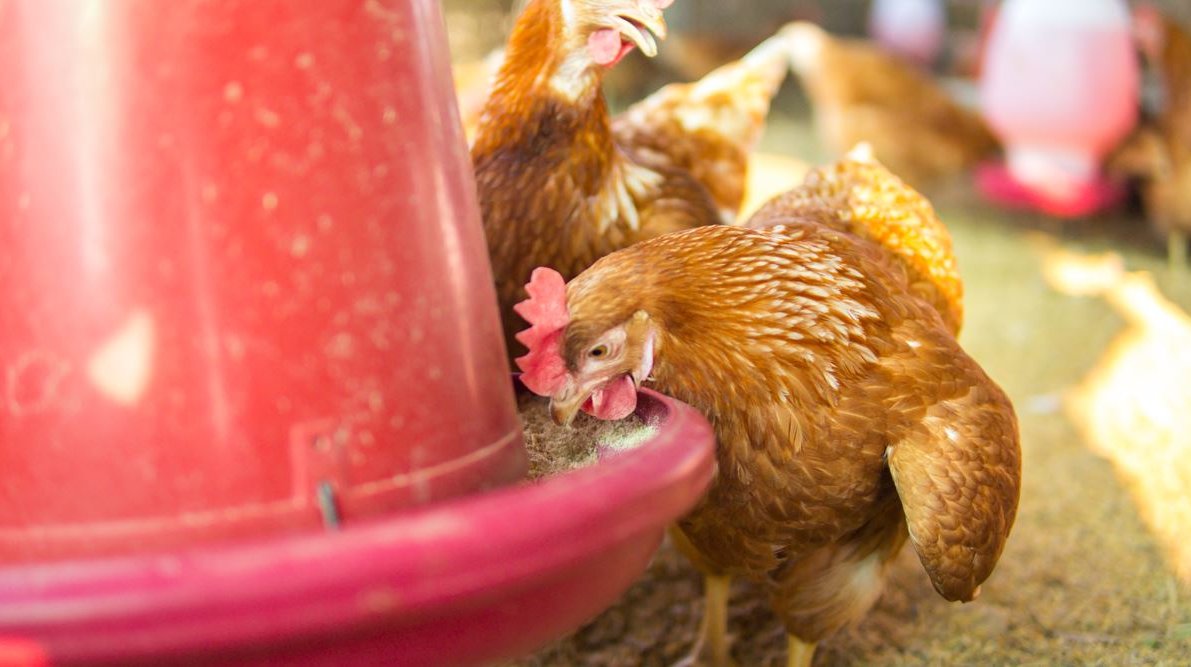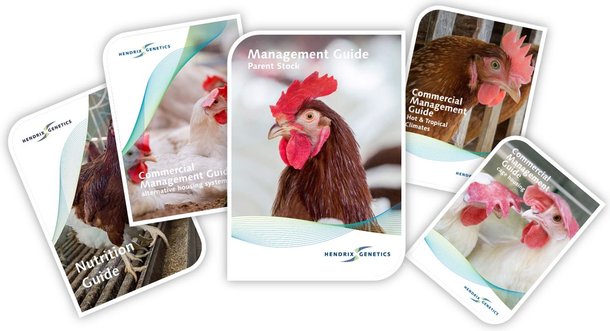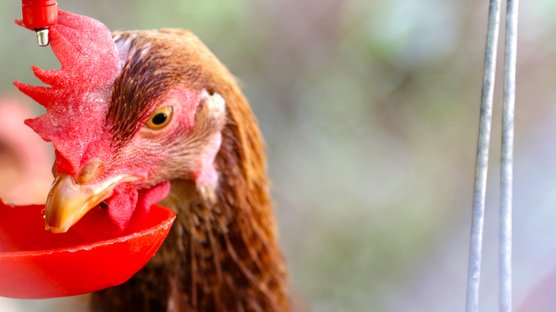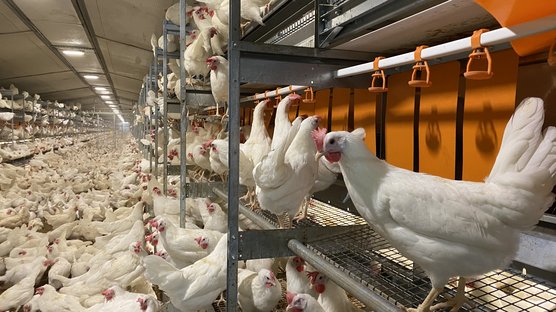
Published on July 13, 2022
Feed Management under Tropical conditions
Heat stress affects the nutrient utilization of laying hens via several ways. At first, when the hens are incapable of temperature regulation, they will reduce their feed intake. At second, it is important to remember that chickens are not able to sweat. To lose their heat during panting, a process which requires energy. Heat stress can result in decreased feed intake, nutrient deficiency, respiratory alkalosis, and poor eggshell quality. High temperatures can raise the level of corticosteroids and this results in oxidative stress. This all affects laying hen performance and can increase mortality.
Besides decreased feed intake, nutrient digestion and absorption is reduced as well, due to impaired intestinal health. As the blood flow towards the intestines is reduced, the absorption of protein is reduced, resulting in decreased protein synthesis. This reduction can easily result in a nutrient deficiency, when this is the case growth during the rearing period will be reduced, the onset of lay postponed, and the flock will respond less uniform. Besides it will negatively affect the entire productive life of the laying hen: less 1st quality eggs will be produced, and average egg size will be lower.
Impact of heat stress on eggshell quality
Panting reduces the CO2 level in the blood and consequently increases blood pH. To compensate for the increased blood pH, the hen will increase her urine production and consequently lose moisture and electrolytes, resulting in dehydration as sodium and potassium are important electrolytes. An increased blood pH reduces the availability of calcium for eggshell formation, as the calcium in the blood results in an increase in blood pH. In addition, laying hens have a reduced feed (and therefor calcium) intake, a reduction in calcium binding proteins (calbindin), and a reduction in estrogen and therefore activation of vitamin D3 in the kidney, all resulting in a reduced amount of calcium for eggshell formation.
Feed formulation
Adaptation in feed formulation can help the laying hens to reduce the negative effect of heat stress. However, feed changes result in an extra stressor and can result in a temporary lower feed intake, therefore it is recommended to not change the formulation when there is a short-term heat stress.
Energy and protein
Replacing part of the carbohydrates by fat, will reduce the heat increment (increased heat production due to feed consumption) of the birds, as metabolizing fat results in less heat increment compared to carbohydrates and therefore lower the heat production from digestion. Besides, the addition of extra fat is increasing the palatability of the feed, which will stimulate feed intake. Increasing fat levels will help to increase the energy content of the feed, which can compensate partly for the reduced feed intake. Feeding higher digestible protein sources or a higher amount of synthetical amino acids will help the birds to maintain the daily amino acid intake. As amino acids are mainly deposited in the egg, the amino acids content in the feed should be adapted to real feed consumption noticed.
Vitamins and minerals
It is recommended to increase the level of bicarbonate via adding sodium bicarbonate to the feed, by formulating both on Sodium and Chloride levels, but electrolytes can be added via the drinking water as well. Vitamin E and C can minimize oxidative stress and so cell damage. Choline and Betaine can help to maintain the osmotic balance to protect cells for dehydration. While magnesium and vitamin C can reduce the cortisol level. If vitamins are added on the water lines, pay attention to the dilution and water quality prior and after usage.
Feed Management
It is highly recommended to prevent feeding the birds during the hottest periods of the day, best moments are the morning and late afternoon. Make sure that feed is always available during these cooler periods. Installing extra drinkers and feeders can stimulate feed and water intake (less competition). If body weight targets are not reached during the rearing period, delay the shift from one feed phase to another till the pullets have reached their target body weight.
Feed particle size and diet palatability
When severe heat stress occurs, it can help to feed a more palatable diet, to stimulate the feed intake. This can be done via adding oil, molasses, or water on the feed. Feeding a mash diet with less fines (max 10% below 0.5mm) will reduce the time that the birds spend eating and will increase feed intake. For the first 5 weeks of age, a crumbled diet is recommended to achieve the right body weight development.
Midnight snack
To stimulate feed intake, midnight feeding can be implemented. This 1.5 to 2 hours of light in the middle of the dark period encourages water and feed intake and hence growth. Furthermore, it helps to provide calcium during the period of intensive shell deposition. Providing light from 4 to 20 hours and at night from 23 hours to 1 o'clock in the morning is widely adopted in hot countries, between latitudes 20° north and 20° south.
Calcium management
To optimize eggshell quality, it is important to take the quantity of calcium in the diet into account, the size of the calcium particles and the time that calcium is provided. With a pre-lay diet (fed till approx. 2% production) you safeguard the development of medullary bone, which functions as a calcium reserve. Preferably coarse calcium (2-4mm) is fed in the late afternoon, this will allow calcium to be available during the eggshell formation period. It is helpful to add extra coarse limestone on top of the feed in the late afternoon. This can be added manually, mixed, on top of the feed or in separate feeders.
Water Quality
Laying hens will increase their water intake, during periods of heat stress. Water quality is extremely important under tropical conditions, since the bacterial load (e.g., E. Coli) are rapidly increasing during hot and humid conditions. This bacterial load not only affects the drinking water quality, but also litter quality if water spraying (evaporation) is applied.
Chickens are consuming most of the water during the end of the day. It is important to provide clean, fresh drinking water of the correct temperature during the entire day, but especially at the end of the day. This will help to encourage the birds to drink and consequently eat. Flushing water lines will help to maintain water at the correct temperature and quality. Please note, the cooler the drinking water, the better the birds can tolerate the high environmental temperatures. Protecting water reservoirs and the plumbing from direct sunlight is essential in keeping the water as cool as possible. It is very important to flush the water and drinking systems after adding water supplementations to support your birds to deal with heat stress. Flushing the system will help to prevent bacterial growth in the water lines and possible change in the taste of the water.

How to support your birds in hot and tropical climates?
- Texture: a coarse mash with added oil will reduce the time and energy spend on eating and therefore will stimulate feed intake compared to a fine mash.
- Feeding times: try to run the feeders in the morning and late afternoon, to encourage feed intake during the cooler periods of the day. A midnight snack can be an interesting tool to increase feed intake in the middle of the night, when the environmental temperatures are in general cooler.
- Water: flush the water system regularly, this will result in availability of fresh and cool water to the flock.
- Higher amino acid levels in the feed can support egg production, as feed intake is reduced, and the daily nutrient intake equals the feed intake times the concentration.
- Replace part of the energy towards an oil or fat source instead of carbohydrates. As fat results in a lower heat increment compared to carbohydrates




